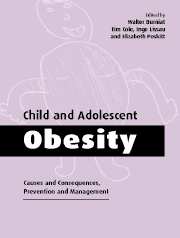Book contents
- Frontmatter
- Contents
- List of contributors
- Foreword
- Preface
- Part I Causes
- Part II Consequences
- 7 Clinical features, adverse effects and outcome
- 8 The obese adolescent
- 9 Prader–Willi and other syndromes
- 10 Hormonal and metabolic changes
- 11 Risk of cardiovascular complications
- Part III Prevention and management
- Index
8 - The obese adolescent
Published online by Cambridge University Press: 02 November 2009
- Frontmatter
- Contents
- List of contributors
- Foreword
- Preface
- Part I Causes
- Part II Consequences
- 7 Clinical features, adverse effects and outcome
- 8 The obese adolescent
- 9 Prader–Willi and other syndromes
- 10 Hormonal and metabolic changes
- 11 Risk of cardiovascular complications
- Part III Prevention and management
- Index
Summary
Biophysical factors
Introduction
Adolescence is a key period in life for major physiological and psychological change. Obesity, perhaps dating from infancy, may peak in severity at adolescence. It is thus highly desirable to intervene with vigorous preventive or curative actions early in life.
However, adolescents' aspirations and their developing capacity to control their own lives can act as useful adjuncts to the management of obesity in those for whom earlier interventions have been unsuccessful. From the practical point of view, it is critically important that adolescents understand the biological processes affecting them. Stressing the advantages (e.g. growth spurt, increased fat-free mass (FFM) and, as a consequence, increased energy expenditure and requirements) as well as the disadvantages (e.g. increased fat mass in girls) of the pubertal changes in body composition can help adolescents feel more in control of weight management. The differences that develop between sexes should be discussed so that they are understood, accepted and not just seen as further disadvantages for subjects already suffering low self-esteem.
Adolescents also want better understanding of their own behaviour. A recent study from the United States found 24% of a nationally representative sample of adolescents were overweight, but 45% of the girls and 20% of the boys had been dieting, and 13% and 7% of girls and boys, respectively, reported disordered eating. The risk of disordered eating increased during adolescence and correlated with depressive patterns of behaviour (Kaltzman et al., 2000).
- Type
- Chapter
- Information
- Child and Adolescent ObesityCauses and Consequences, Prevention and Management, pp. 154 - 170Publisher: Cambridge University PressPrint publication year: 2002
- 4
- Cited by



